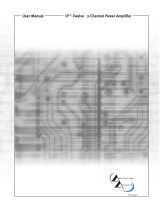
1
Save the carton and packing materi-
als! Should you ever need to ship the
unit, use only the original factory pack-
ing.
For replacement packaging, call Crest Audio’s
Customer Service Department directly.
2
Read all documentation before
operating your equipment. Retain all
documentation for future reference.
3
Follow all instructions printed on
unit chassis for proper operation.
4
Never hold a power switch or cir-
cuit breaker in the "on" position,
if it won’t stay there by itself!
5
Do not use the unit if the electrical
power cord is frayed or broken.
The power supply cords should be
routed so that they are not likely to be
walked on or pinched by items placed
upon or against them.
6
Always operate the unit with the
AC ground wire connected to the
electrical system ground. Precautions
should be taken so that the means of
grounding of a piece of equipment is not
defeated.
7
Damage caused by connection to
improper AC voltage is not cov-
ered by any warranty. Mains voltage
must be correct and the same as that
printed on the rear of the unit.
8
Do not ground any hot (red) terminal.
Never connect a hot
(red) output to
ground or to another hot (red) output!
9
Power down and disconnect units
from mains voltage before making
connections.
0
Do not drive the inputs with a
signal level greater than that
required to enable equipment to
reach full output.
¡
Do not run the output of any ampli-
fier channel back into another chan-
nel’s input.
Do not parallel- or series-con-
nect an amplifier output with any
other amplifier output.
Crest Audio is not responsible for damage
to loudspeakers for any reason.
Ô
Do not connect the inputs or
outputs of amplifiers to any other
voltage source: such as a battery,
mains source, or power supply, regard-
less of whether the amplifier is turned
on or off.
£
Connecting amplifier outputs to
oscilloscopes or other test equip-
ment while the amplifier is in bridged
mono mode may damage both the
amplifier and test equipment!
¢
Do not spill water or other liquids
into or on the unit, or operate the
unit while standing in liquid.
ˆ
Do not block fan intake or exhaust
ports.
Do not operate equipment on
a surface or in an environment
which may impede the normal
flow of air around the unit: such
as a bed, rug, weathersheet, carpet, or
completely enclosed rack.
§
If the unit is used in an extremely
dusty or smoky environment: the
unit should be periodically blown free
of foreign matter.
¶
Do not use the unit near stoves,
heat registers, radiators, or other
heat producing devices.
ƒ
The power cord of equipment
should be unplugged from the out-
let when left unused for a long
period of time.
Service Information
Do not remove the cover!
Removing the cover will expose you to
potentially dangerous voltages. There are
no user serviceable parts inside.
Equipment should be serviced by
qualified service personnel when:
A. The power supply cord or the plug has
been damaged.
B. The equipment has been exposed to rain.
C. The equipment does not appear to oper-
ate normally, or exhibits a marked change
in performance.
D. The equipment has been dropped, or the
enclosure damaged.
To obtain service:
contact your nearest Crest Audio
Service Center, Distributor, Dealer,
or Crest Audio at 201.909.8700
USA
or visit www.crestaudio.com for addi-
tional information.
email techserve
@crestaudio.com
This symbol is used to alert
the operator to follow important
procedures and precautions
detailed in documentation.
This symbol is used to warn opera-
tors that uninsulated “dangerous
voltages” are present within the
equipment enclosure that may
pose a risk of electric shock.
important precautions
WARNING
THE ON/OFF SWITCH IN THIS APPARATUS
DOES NOT BREAK BOTH SIDES OF THE MAINS.
HAZARDOUS ENERGY MAY BE PRESENT INSIDE
THE ENCLOSURE WHEN THE POWER SWITCH IS
IN THE OFF POSITION.





















